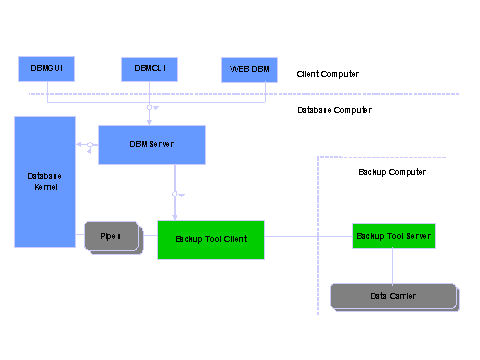 Block Diagram: Backing Up and
Restoring
Block Diagram: Backing Up and
Restoring 
The following block diagram illustrates the software components that are involved when you back up and restore data, and shows how they work together with a backup tool.

Description of the Backup Process
The Database Manager client is used to send the command that saves the data; this calls the DBM Server program. If you are using a UNIX operating system, the DBM Server creates one or more pipes. If you use Microsoft Windows, the pipes are created by the database kernel. The DBM Server sends the information that starts the backup process to the database kernel. As soon as the data is written to the pipes, the DBM Server program calls the backup tool. The backup tool reads the data from the pipes and saves it on a data carrier.
Description of the Restore Process
The Database Manager client is used to send the command that restores the data; this calls the DBM Server program.
If you are using a UNIX operating system, the DBM Server creates one or more pipes. If you use Microsoft Windows, the pipes are created by the database kernel.
The DBM Server sends the information that starts the restore process to the database kernel. The program then calls the backup tool and transfers the information about which backup has to be restored.
The client of the backup tool requests the specified data carrier from the backup server. The server gets the data carrier, reads the data of the backup, and transfers the data to the client of the backup tool. The client writes the data to the pipes. There the data is read by the database kernel and transferred to the database system.
